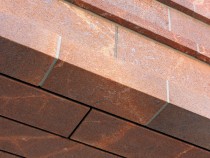
© Frank Kaltenbach
Facades of stone stand the test of time – and this makes the material an apt choice for a religious building. We decided to work with a volcanic rock from central Saxony known as Rochlitz porphyritic tuff whose varying levels of iron-oxide produce a lively variety of colours in the spectrum ranging from red, grey to yellow, and which contains quartz and feldspar.
Porphyritic tuff is a soft, highly porous stone; following major volcanic eruptions some 280 million years ago it formed about 30 km below the earth’s surface. On account of its outstanding characteristics (e.g., ease in processing, frost-resistance) Rochlitz Ignimbrit, as it is officially known, has been used as a building material since the tenth century, and this is evident in many of west Saxony’s cities. But because the nearby river is not navigable, the material did not spread beyond the region. This fact makes the stone a truly local material – and a recognizable sign that the new priory church is part of Leipzig’s building tradition.
But the material is far more than adornment: as homogeneous envelope, the stone plays a decisive role in arriving at the sculptural form of the building. Up close the characteristic yellow streaks, zones bleached by iron oxide, become apparent.The projecting and receding layers of stone are a reinterpretation of the region’s architectural tradition. (Ansgar Schulz, Benedikt Schulz)
Porphyritic tuff is a soft, highly porous stone; following major volcanic eruptions some 280 million years ago it formed about 30 km below the earth’s surface. On account of its outstanding characteristics (e.g., ease in processing, frost-resistance) Rochlitz Ignimbrit, as it is officially known, has been used as a building material since the tenth century, and this is evident in many of west Saxony’s cities. But because the nearby river is not navigable, the material did not spread beyond the region. This fact makes the stone a truly local material – and a recognizable sign that the new priory church is part of Leipzig’s building tradition.
But the material is far more than adornment: as homogeneous envelope, the stone plays a decisive role in arriving at the sculptural form of the building. Up close the characteristic yellow streaks, zones bleached by iron oxide, become apparent.The projecting and receding layers of stone are a reinterpretation of the region’s architectural tradition. (Ansgar Schulz, Benedikt Schulz)












